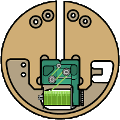Fletching glue trouble shooter
- Details
- Category: Guidance
- Published: Wednesday, 09 December 2020 03:03
- Written by Super User
- Hits: 1622
I see a lot of questions on Archery talk about what fletching glue to use and what works best bla bla bla. Then the next question is "They aren't sticking very well what went wrong?"
First Answer the glue that works best is the glue that works best for you. OK, I agree that is an asinine answer and I apologize but the truth of the matter is that there are a lot of glues that will work. I would encourage you to try several because you may prefer the properties of one over another. I personally have always used the Bohning Platinum Fletch-Tite glue. It is a slow drying flexible glue that I find adheres to the vanes really well and tends to absorb impacts reasonably well. A lot of people swear by the super glue products so I will assume they work well too. Gorilla super glue the Lucite Gel super glue… and so on.
With any glue the surface preparation is the secret to getting it to stick well. Vanes are a molded plastic and the process of molding the vanes a release agent is applied to the mold. This helps increase the manufacturing speed and reduce molding errors. That release agent is created for the sole purpose of preventing sticky things from sticking. Sooooo… you need to get it off the vanes to ensure proper adhesion. I find that a vigorous scrubbing with denatured alcohol (not rubbing alcohol) does an excellent job of removing the release agent. I place the vane in the clamp and then I use a paper towel with a generous squirt of alcohol on it. I don’t reuse the same area of the towel twice. I use significant pressure to ensure I’m mechanically and chemically removing the release agent. Typically I’ll also see color pigment transferred to the towel and this is to be expected. I have never had a problem with vane adherence when I have employed this method. Caution Denatured Alcohol is a volatile chemical that will damage your liver with prolonged exposure so always wear rubber gloves when working with it. A well ventilated area is also a good idea.
The arrow surface also needs to be prepped. Again I use Denatured alcohol and clean each arrow thoroughly. I typically get them squeaky clean. A lot of people swear by using Acetone for the arrows. I believe this to be overkill and exponentially more toxic and smelly. The arrow surface is most often contaminated with the oils from your hands and that is easily removed with the Denatured alcohol so yes after you clean them avoid touching the areas you just cleaned. I have also seen in some cases where budget acetone also has some trace oils in it that leave a residue. Obviously that is counterproductive. I have had some arrows that no matter what I did I just could not get a glue to stick to them I tried acetone, alcohol, Ajax, sandpaper, methyl ethyl ketone… everything, and the vanes just would not stay stuck. This was with only one set of arrows and it is not at all common. In that particular case I resolved the problem by using a vinyl arrow wrap.
Vinyl arrow wraps can be attractive and a great way to customize your arrows. They are very popular and I personally like them better for my arrows. The drawback is that often when you damage or lose a fletch the wrap is also damaged or not cleanable. You’ll have to replace the wrap and the 2 other undamaged fletchings to get the arrow back to 100%. Since I subscribe to the old adage better archery through aggressive spending wraps work great for me. Again vinyl arrow wraps need to be cleaned with denatured alcohol prior to adhering the vanes.
How do I know what went wrong?
There is a simple way to ID what you need to change in your arrow building process. Take a look at both surfaces, the arrow and the fletch after the failure.
• If the glue remains on the arrow and not on the fletch then it is likely you did not clean the fletch well enough. It is possible the glue that you are using won’t stick to the fletching plastic but it is far more likely the problem is related to a cleaning prep problem.
• If the glue is stuck to the vane and not the arrow then you need to clean the arrow better or again find a glue that will stick to the carbon is required.
• If there is glue still stuck to both the fletch and the shaft then it is possible that the glue you are using is actually failing. The glue may not be strong enough to handle the pounding an arrow gets or it could be bad. The age of a glue often affects its effectiveness so ensure you are using glue that isn’t ancient. It is also possible that the particular lot of glue you are using is just plain bad. This is uncommon but possible.
Building your own arrows can be a cost saving endeavor as well as a project you can be proud of. Remember clean clean clean and investigate problems, you’ll soon discover a winning process you can use to build a functional and reliable arrow. Have fun and shoot straight.


